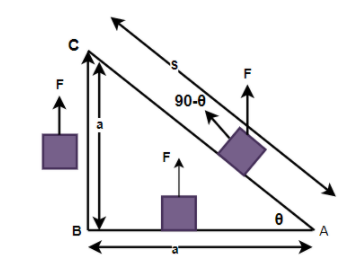
Answer
106.8k+ views
Hint: Displacement depends only on initial and final position. So, the force can be considered as conservative. Work done is given by$W = Fs\cos \theta $. Using this expression find out the work done in both paths and compare them.
Complete step-by-step answer:
Work done by an object is defined as a scalar product of the force and the displacement of the body.
$W = \vec F.\vec s$
$W = Fs\cos \theta $
Here, \[F\]is the force applied on the body and\[\;s\] is the distance through which the body has displaced.
Consider the work done by the body in the path AC,
${W_{AC}} = Fs\cos (90 - \theta )$
${W_{AC}} = mg\sin \theta \left( {\because F = mg} \right)$
${W_{AC}} = mgh \to (1)$
For path AB
${W_{AB}} = Fs\cos 90$
${W_{AC}} = 0$
For path BC
${W_{BC}} = Fs\cos 0$
${W_{BC}} = mgh$
So work done along the path ABC is
${W_{ABC}} = {W_{AB}} + {W_{BC}}$
${W_{ABC}} = mgh \to (2)$
From equation (1) and (2) we know that the work done by the force is the same in both paths.
Hence, the correct option is A.
Note: One can simply see that the starting and the end points in both the paths are the same. Since gravity is a conservative force, we can say that there is no difference in the works.
Work is said to be 1 joule, when 1 newton of force displaces the body through 1 meter in its own direction. The SI unit of work is joules, CSG unit is erg .
Relation between joule and erg.
$1joule = {10^7}erg$
Its dimensional formula is $\left[ {M{L^2}{T^{ - 2}}} \right]$
Complete step-by-step answer:
Work done by an object is defined as a scalar product of the force and the displacement of the body.
$W = \vec F.\vec s$
$W = Fs\cos \theta $
Here, \[F\]is the force applied on the body and\[\;s\] is the distance through which the body has displaced.
Consider the work done by the body in the path AC,
${W_{AC}} = Fs\cos (90 - \theta )$
${W_{AC}} = mg\sin \theta \left( {\because F = mg} \right)$
${W_{AC}} = mgh \to (1)$
For path AB
${W_{AB}} = Fs\cos 90$
${W_{AC}} = 0$
For path BC
${W_{BC}} = Fs\cos 0$
${W_{BC}} = mgh$
So work done along the path ABC is
${W_{ABC}} = {W_{AB}} + {W_{BC}}$
${W_{ABC}} = mgh \to (2)$
From equation (1) and (2) we know that the work done by the force is the same in both paths.
Hence, the correct option is A.
Note: One can simply see that the starting and the end points in both the paths are the same. Since gravity is a conservative force, we can say that there is no difference in the works.
Work is said to be 1 joule, when 1 newton of force displaces the body through 1 meter in its own direction. The SI unit of work is joules, CSG unit is erg .
Relation between joule and erg.
$1joule = {10^7}erg$
Its dimensional formula is $\left[ {M{L^2}{T^{ - 2}}} \right]$
Recently Updated Pages
Write a composition in approximately 450 500 words class 10 english JEE_Main

Arrange the sentences P Q R between S1 and S5 such class 10 english JEE_Main

Write an article on the need and importance of sports class 10 english JEE_Main

Name the scale on which the destructive energy of an class 11 physics JEE_Main

Choose the exact meaning of the given idiomphrase The class 9 english JEE_Main

Choose the one which best expresses the meaning of class 9 english JEE_Main





